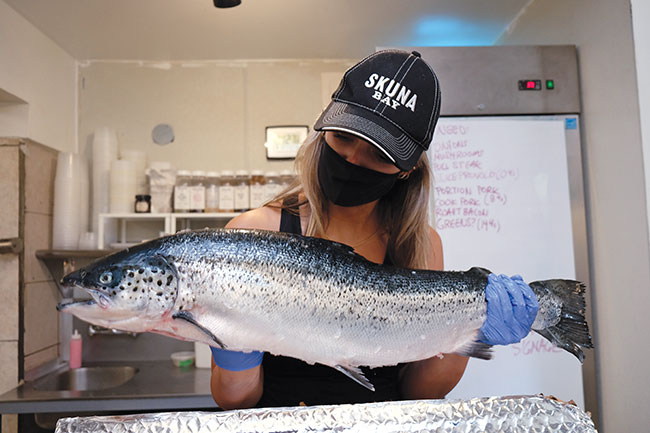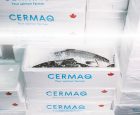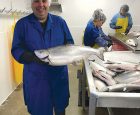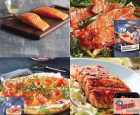
Salmon farmers poised to be part of post-COVID recovery
November 18, 2020
By Jennifer Brown
Crisis sharpens focus on industry as pillar of the community and economy
 Staff holds Skuna Bay Salmon, a premium brand of Grieg Seafood BC that’s sold in North America. Throughout the pandemic, salmon farmers kept operations going
Staff holds Skuna Bay Salmon, a premium brand of Grieg Seafood BC that’s sold in North America. Throughout the pandemic, salmon farmers kept operations going
As salmon farmers in North America brace for what market demand will look like heading into 2021, they are also feeling optimistic they will be part of the global economic recovery in a post-COVID world.
“I think that one of the positive outcomes of the pandemic for the industry is that we’ve proven how reliable we are as a contributor to the economy,” says Rocky Boschman, managing director of Grieg Seafood in Campbell River, British Columbia. “We’ve done five years of learning in six months.”
“I think that many levels of government have learned a lot more about our industry in the last short while because they have become interested in terms of what industries can contribute to a post-COVID recovery.”
Throughout the pandemic, salmon farmers in North America kept operations going, in some cases adding staff, as Grieg Seafood BC did. The company hired 20 additional people to help manage the harvest.
“The biggest challenge to us was that almost overnight, 50 percent of our traditional business went away, and that’s the hotels, restaurants and foodservice,” says Boschman. “But very quickly we adapted to continue supplying all of that extra volume into retail, which was the only channel we had left.”
Determined to try to do business as “normal” as possible and protect jobs, Grieg and others muscled through the pandemic, maintaining operations and production, while making the safety of employees a priority.
“We haven’t had any interruption in harvesting,” says Boschman. “This was our biggest harvest year ever. We’ve managed to continue to harvest every single week, in some cases more than two million pounds a week and move that through the processing plants and distribution channels into the market.”
The “Blue Economy” was even referenced in the Throne Speech delivered September 23 to Parliament in Ottawa. It noted a need to “grow Canada’s ocean economy to create opportunities for fishers in coastal communities while advancing reconciliation and conservation objectives.”
“We can and want to be in that space,” says David Kiemele, managing director of Cermaq Canada. “Indigenous relationships are immensely important to us here on the Coast. We enjoy several very positive and long-standing agreements here on the coastline. Indigenous oversight, governance of our operations, and being transparent is what we’re all about.”
Launching into new markets
When COVID-19 emerged in March and salmon farmers were deemed an essential service, companies focused on how to continue production while keeping operations safe for employees.
“One of the biggest challenges was finding ways to keep our people safe to continue to operate and allow our product to enter the market,” says Kiemele. “There were a lot of changes to processes that needed to take place across all of our facilities to make sure we could continue to operate. There were some nervous moments, but I can’t say enough about the work ethic and professionalism of the team here, and we’ve navigated through the situation quite successfully to date.”
Kiemele describes the impact of the pandemic as a “complete decimation of the foodservice industry” with restaurants and cafes closing down.
“But what we did see, that somewhat counterbalanced the decrease in foodservice, was the increase in retail,” he says.
Like so many seafood companies, the impact of COVID-19 prompted Cooke Aquaculture to consider alternative means of getting the product to market. In May, Cooke’s distribution company in Nova Scotia, AC Covert, launched a new home delivery service of seafood boxes available online across Nova Scotia, New Brunswick and Prince Edward Island.
The company has since expanded the overnight delivery to Ontario, Manitoba, Alberta, and Saskatchewan.
“The pandemic challenges required us to pivot our thinking as a seafood company and how we can supply our fresh, sustainable product to those who enjoy it,” says Joel Richardson, vice-president of public relations, Cooke Inc. “The design and delivery of these seafood boxes have been a hit in Atlantic Canada, and we thought it was a perfect time to offer it to our customers in different areas of the country.”
Creative Salmon general manager Tim Rundle said while the pandemic has been challenging for multiple reasons, he’s proud of how the entire team at Creative has pulled together.
“We have continued with all of our operations, with, of course, the required changes to focus on the health and safety of staff. We will continue to monitor the entire situation so we can continue to adjust as needed,” Rundle says. “Creative Salmon makes up only about 3 percent of the farmed salmon production in British Columbia. We are certified to the Canadian Organic Aquaculture Standard and farm Chinook (King) salmon, so those pieces set us apart.
“We are always open to engaging with people interested in our unique product and in finding new customers.”
While the foodservice sector is still depressed, Kiemele says it has come back somewhat over the last few months as restrictions were lifted in Canada. But as the weather turns cold in North America, outdoor dining options are coming to a grinding halt.
Dean Dobrinsky, human resources director at Mowi Canada West, says the company has also made a more significant shift from wholesale distributor to retail.
“We have to chase markets where we need to,” he says. “All of this has been a reminder of how dedicated and nimble our employees can be in that they took on a massive change to work practices, safety equipment, safety process – we did all of that and production continued, and no one got hurt. We’re taking it all day by day.”
Advertisement
- Canada set to move forward with planned net pen transition
- Niche market cushions COVID blow for tilapia producer










